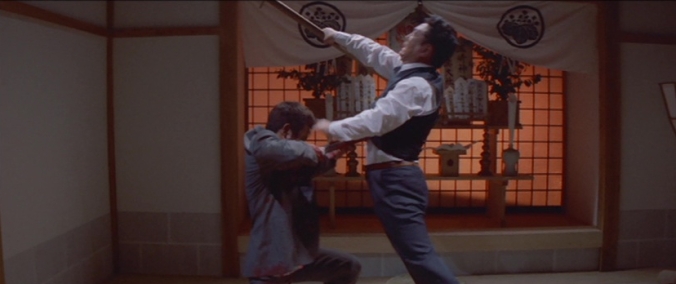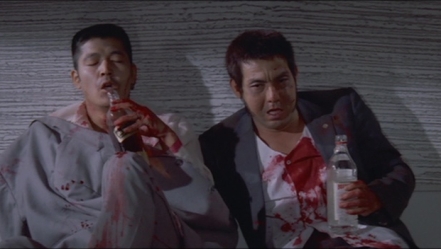 Blood for Blood is a yakuza movie remarkable primarily for Jo Shishido’s sidesburns and Hajime Kaburagi’s music score.
Blood for Blood is a yakuza movie remarkable primarily for Jo Shishido’s sidesburns and Hajime Kaburagi’s music score.
Shishido plays the standard yakuza #2 just released from prison to find his old gang under pressure both from traditional enemies and from new, larger Tokyo gangs as well. After a while, there are so many different gang names thrown at us that it becomes impossible to keep up with who is after whom and for what reason. Throw in the additional complication that the daughter of Shishido’s boss has married a man who wants out of the yakuza world instead of Shishido, who has loved her in vain, while the sister (Mieko Kaji) of the local opposition gang leader has always been in love in vain with Shishido, and the result is a plot line that is beyond explication except in such detail as to occupy several blogs.
Unusually for a yakuza movie not directed by Fukasaku, the film is all go-go-go. Directed by Yasuharu Hasebe, it is Nikkatsu “borderless action” attitudes pasted almost unchanged over a “chivalrous yakuza” storyline itself moved to the seventies. Hasebe was a leader in the second wave of borderless action specialists, making his debut in 1966 and most noted today outside Japan for his Stray Cat Rock movies. As in all true borderless action movies, characters are stereotypes, and when in doubt, the story simply adds another complication, another double-cross, another fight. At one point three different people from three different gangs are hiding out in Kaji’s diner for three different reasons, It’s so confused that at one point Shishido forgets where he was shot and changes his wound grab half-way through the take. But the movie never drags. Once you say to yourself, “I can’t keep up with who is mad at whom or why, so I won’t bother,” it whizzes along to a rather striking series of jump cuts as the dying Shishido and his buddy wait for their ultimate enemy to arrive and be killed. Hasebe is never without imagination, such as framing the movie with a set of sandals at the beginning that turn out to be worn by gangsters on their way to a fight and at the end by Shishido’s and his buddy’s bloody sandals as they stagger into the big villain’s house. Nobody seems to be aware that they are in an incomprehensible plot in a story that has already been told a couple of thousand times.
Hasebe is never without imagination, such as framing the movie with a set of sandals at the beginning that turn out to be worn by gangsters on their way to a fight and at the end by Shishido’s and his buddy’s bloody sandals as they stagger into the big villain’s house. Nobody seems to be aware that they are in an incomprehensible plot in a story that has already been told a couple of thousand times.
Kaji makes far more than expected of her clichéd abandoned lover role, indicating there was a real actress under the exploitation movie queen who would not be fully visible until Double Suicide at Sonezaki seven years later.
Shishido plays Shishido, often upstaged by his remarkable sideburns that both exaggerate his cheeks and sometimes seem unattached to the rest of his hair.
The real star of the movie, however, is its soundtrack. Kaburagi was one of the most prolific screen composers of Japanese history (nearly 250 credits), often notable for taking an approach that is completely unexpected. Here he outdoes himself. It is a terrific score in which its every appearance drives the movie forward. However he also does something rarely found in movies anywhere. Most movie composers will follow one of two paths; (1) a series of motif’s a la Wagner, so there is a main theme, a love motif, a tension motif, an action motif, a death motif, etc, and replay them at various lengths as needed, or (2) a form often used in Japanese movies, write simply one or two themes and just re-use them, sometimes exactly the same* and sometimes in different arrangements to fit changing moods. Here, as far as I can tell from a single viewing, Kaburagi does neither – he composes something new for every sequence. And it is always the “right” music for the sequence. Generally, the definition of a great movie score is one you don’t notice after the main title, so in that sense, it would not be accurate to call it a great score. This is the exception to that rule, a great score that lifts a C level script into at least B+ territory.
The 90 minutes fly by as they should in a real popcorn movie, or whatever Japanese audiences ate in place of popcorn in 1971. At the same time, it is a major marker in the serious change in Japanese audience expectations during the early seventies. It indicates an attempt by Nikkatsu to keep up with Toei’s yakuza movies while maintaining the Nikkatsu look. The blood and violence on hand is a marked increase from the original borderless action movies, though the nudity and violence toward women of later Nikkatsu action movies is still missing.
* This is relatively rare in American movies, but there are examples to be found, such as Laura. It is no surprise that everyone left humming the theme, since that is all they heard in the course of the movie.


Theater patrons in Japan crunch on iwashi senbei, or dried sardines. The small fish are baked whole in soy sauce and sugar, and topped with sesame seeds, giving the sardines a sweet and savory umami flavor. I remember them from the theatres in Honolulu in the early 1970’s where they were called iriko.
LikeLiked by 1 person
Another cultural mystery solved. Thanks.
LikeLiked by 2 people